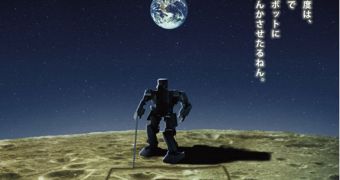Landing things on the Moon, be they a human crew or scientific equipment, is a monumental task, and one that requires a lot of planning in addition to a perfect execution. Manned missions are especially difficult, because spacecrafts carrying humans also need to include life-support systems and other special requirements. But sending robotic explorers is a lot easier, and this is precisely what a team of Japanese engineers plans to do. The group wants to deliver a humanoid-shaped robot on the surface of the Moon by 2015, Space reports.
The task will not be simple, the scientists admit. They recognize the fact that their endeavor comes with a huge price tag that should cover both development of the robot itself and the delivery system. However, according to Japanese sources, the Astro-Technology SOHLA manufacturing cooperative is hopeful that it will be able to secure all the funding necessary for their plan. The prospect of a two-legged humanoid robot walking the surface of the Moon is bound to be appealing to at least a few major investors, the group believes.
“We decided on a human-like robot because it's more fascinating and stimulating for us. We'll make an attractive robot to carry our dreams to the Universe,” told the Daily Yomiuri newspaper Hideo Sugimoto, who is the director of the Osaka Prefecture, Honshu-based SOHLA association. At this point, it is estimated that constructing the Maido-kun robot will take about 1 billion yen (around $10.6 million) to complete. The official added that the collaboration was hopeful they would be able to deliver their robot to the Moon aboard the same spacecraft that the Japanese Aerospace Agency (JAXA) would use to send its own explorer in 2015.
Engineers at JAXA also analyzed the possibility of constructing a two-legged robot for lunar exploration, but the plan was eventually dropped in favor of a wheeled robot. The decision was supported by the fact that wheeled explorers tend to experience less technical difficulties, and that they are generally easier to construct and maintain. On the sandy soil of the lunar surface, a wheeled vehicle makes even more sense. But engineers at Astro-Technology SOHLA hope to be able to prove these predictions wrong with their new robot, the Japanese press reports conclude.

 14 DAY TRIAL //
14 DAY TRIAL //